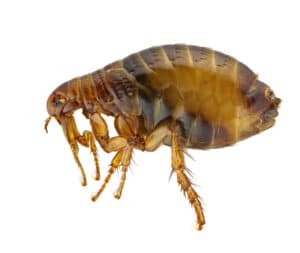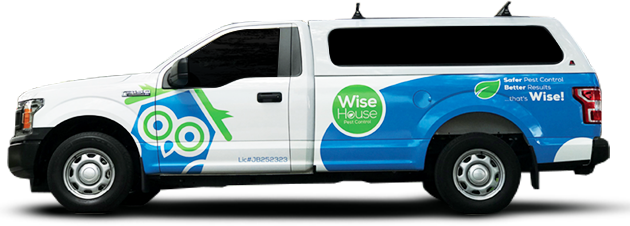In South Florida, dealing with fleas can quickly escalate from a small annoyance to a significant problem if not addressed promptly. These tiny pests are skilled at infiltrating homes and can multiply rapidly, affecting not just your pets but your entire living space.
Understanding how to spot fleas early and taking proactive steps to control them is important for keeping your home comfortable and pest-free. From recognizing the signs of an infestation to implementing effective prevention methods, staying ahead of these unwelcome guests is key.
In this post we navigate the challenges of flea control, offering practical tips on how to identify these pests, manage their presence, and maintain a peaceful living environment for both your family and pets.

Fleas are resilient insects with a life cycle that allows them to reproduce rapidly and establish significant infestations. Their biology and behavior make them challenging pests to manage.
Egg Stage— Flea eggs are small, oval, and white, measuring about 0.5 mm in length. They are laid on the host but can fall off into the environment. These eggs are not sticky, so they can easily end up in bedding, carpets, and other areas where the host frequents.
Larval Stage— Flea larvae are worm-like and about 2-5 mm long. They are blind and feed on organic debris, including flea feces containing dried blood. Larvae avoid light and seek dark, hidden environments such as under furniture or in carpets.
Pupal Stage— Flea pupae are encased in a silk-like cocoon. This stage is highly resilient to environmental conditions and insecticides. Pupae can remain dormant for several weeks to months until they sense a host’s presence through vibrations, heat, or carbon dioxide.
Adult Stage— Adult fleas are the stage responsible for blood-feeding and reproduction. Female fleas can lay up to 50 eggs per day. They begin feeding shortly after emerging from the cocoon, and their bites can cause itching and irritation in their hosts.
Watch Your Pets
Itchy Pets— If your furry friend is scratching, biting, or chewing at their skin more than usual, fleas might be the culprit. Fleas cause intense itching, and pets often try to relieve the discomfort.
Flea Dirt— Look for small black specks in your pet’s fur, known as flea dirt. This is flea feces and can be seen on your pet’s bedding or in their fur. To test, place the specks on a damp paper towel; if it turns reddish-brown, it’s flea dirt.
Visible Flea— Fleas are tiny, reddish-brown insects that are hard to spot, but you might see them moving in your pet’s fur or jumping around.
Check Your Home
Examine your pet’s favorite spots, including beds, carpets, and couches, for fleas or flea dirt. South Florida homes often have cozy pet areas that can harbor these pests. Floors and Upholstery: Flea eggs can fall off your pet and settle in carpets and upholstery. Be sure to check these areas thoroughly.
Look for Flea Bites
Flea bites appear as small, itchy red bumps, often clustered on the lower legs or ankles. If you or your family members are getting bites in these areas, fleas might be the issue.
Flea Treatments— Use vet-approved flea treatments for your pets, such as topical treatments, oral medications, or flea collars. Consistent application is key, especially in South Florida’s flea-friendly environment.
Regular Grooming— Bathe and groom your pets regularly. A flea comb can help remove fleas and eggs from their fur.
Professional Pest Control— If you’re dealing with a serious infestation, consider hiring a pest control service that specializes in flea management.
Living in South Florida means dealing with a climate that’s perfect for fleas. By staying alert to the signs of fleas and taking proactive steps in pet care, home cleaning, and outdoor maintenance, you can enjoy a pest-free environment. Regular attention and prompt action at the first sign of fleas will help you maintain a comfortable and healthy home for your family and pets.
Common signs include frequent scratching by pets, small red bite marks on your skin, and spotting tiny dark brown insects on carpets, furniture, or pet bedding. You may also notice flea dirt, which looks like small black specks.
Yes, fleas can survive indoors for a while without pets. They can latch onto humans or hide in carpets, furniture, and cracks, waiting for a host. Proper treatment is needed to eliminate them entirely.
Vacuum frequently, wash pet bedding in hot water, use flea control products for your pets, and consider using flea sprays or foggers for your home. For severe infestations, professional pest control may be necessary.
Regularly treat your pets with vet-approved flea prevention products, vacuum often, wash pet bedding, and keep your yard maintained by trimming grass and bushes, which reduces flea habitats.

Ready to send away pests without harming your pets? Getting started with Wise House Environmental Services is as easy as 1-2-3:
With Wise House Environmental Services, you get more than just effective pest control; you get peace of mind, knowing that your home is without pests and safer for your pets.
Our approach to pest control combines science with safety, offering you the kind of targeted, effective solutions that you won’t find with just any other pest control service. Our services have made a world of difference for homeowners, and we can do the same for you. Your pets will thank you for it!
We serve Port St. Lucie,Lake Worth, Boyton Beach, Palm Beachand the Treasure Coast.


© 2023 All Rights Reserved. | Sitemap